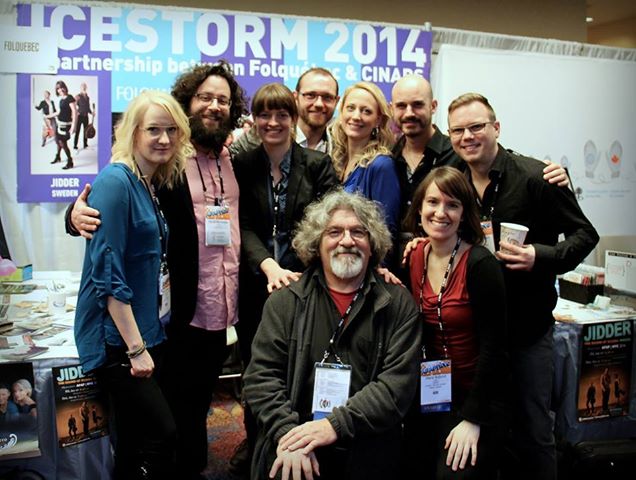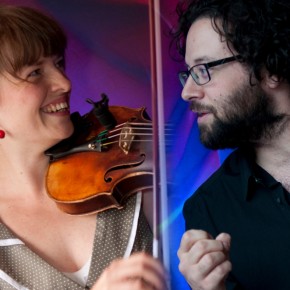Talented artists from the Canadian province of Quebec and the Scandinavian nations of Sweden and Denmark teamed up for an evening of musical showcases in New York City that was a highlight of the Association of Performing Arts Presenters (APAP) Conference, Jan. 10-14.
Called Ice Storm 2014 and presented by Folquebec, a nonprofit organization dedicated to the promotion and dissemination of folk music made in the province, the Friday evening series of showcases took place at the Marjorie S. Deane Little Theater at Manhattan’s West Side YMCA.

Participants in Ice Storm 2014 included Gilles Garand (center), Maja & David, and members of Kongero and Jidder.
“Our project is bringing Quebec music and Scandinavian music together, and the showcase was just an extension of that for us,” said Montreal’s David Boulanger of the duo Maja and David. “And we got a chance to meet some amazing bands with whom we’ve been collaborating this weekend.” His duo partner, Maja Kjaer Jacobsen, from Silkeborg, Denmark, noted that “these bands are so different that it makes for a nice collaboration.
The duo, playing together for 18 months and currently working on a second CD, met in Quebec in 2009 when David – also a member of La Bottine Souriante, the most well-known Quebec trad music band in the world – taught fiddle to Maja’s Danish trad music class which was there on a field trip. A couple of years later, David played a festival there with the band. After he returned to Denmark about six months later to teach at a folk music camp, the two decided to form a duo.
“The traditional music of Denmark and Quebec has so many things in common that we couldn’t let it pass by,” said Maja, noting that their music knows no geographic boundaries. She grew up going to Celtic music festivals and listening to her father play guitar and sing popular folk songs from the British Isles and Ireland. Although the guitar was her first instrument, she took up the fiddle at age 14 and considers Danish traditional music her forte.
David began playing the fiddle at age 8 and was learning to play traditional music on his own by 15. Asked about the geographical challenges facing the musical pair, he said: “People tend to see it as a tough thing to do, but I like to see it as we’re conquering the world from both sides of the Atlantic at the same time.” Of the APAP Conference, he opined: “It’s been great meeting so many new people – presenters and musicians – and making great contacts.”
Gilles Garand, founder and president of Folquebec, echoed those sentiments. “It was an incredible experience this year to work with Cinars and to create something new with the Scandinavians through Ice Storm,” he said.
Folquebec has previously presented an annual showcase and reception in the lobby bar of the conference’s host hotel. In 2013, these featured noted Quebecois folk groups Le Vent du Nord and De Temps Antan, as well as D’Harmo (featuring four of Quebec’s top harmonica players), klezmer group Kleztory, Trio Yves Lambert, and Maz (a quartet whose sound is a mix of electric jazz and traditional music). “We put Quebec music on the map and already have had great success with really talented artists,” said Garand. At last year’s conference, he also conducted a 90-minute session on “The State of Trad: Traditional Folk and Dance Music.”
Noting that the formation of Folquebec stemmed from conversations at a Folk Alliance conference in 2000, Garand, who also serves as president of Society for Preservation of Traditional Dance of Quebec and was artistic director of festivals for more than 20 years, said he views APAP and other conferences as “opportunities to share our knowledge and contribute to the concept of cultural reciprocity among artists.” Garand, who also is engaged in organizing a concurrent traditional music and dance festival called La Grande Rencontre and an international rendez-vous known as the Montreal Trad Conference slated for May 8-11, said he enjoys working on cultural exchange and bringing Quebec artists to the world.
The Ice Storm showcases were just a small part of this year’s APAP Conference that attracted several thousand people. In addition to more than 1,000 showcases, the global performing arts marketplace and multidisciplinary arts business event featured daily plenary sessions, keynote speakers, and professional development workshops and forums. As in years past, exhibition halls teemed with booking agents, representatives of regional and national cultural arts organizations, and presenters eager to speak with them.
A Washington, D.C.-based nonprofit, APAP is a national service and advocacy organization dedicated to developing and supporting a robust performing arts presenters field and the professionals who work within it.


Like/Follow Us!